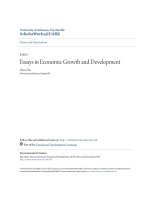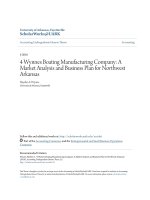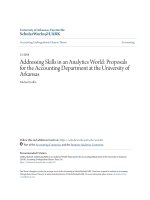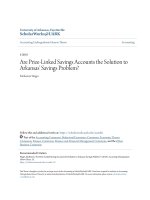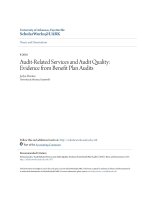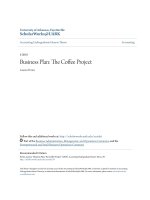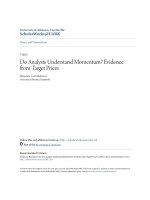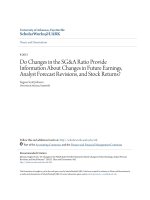Accounting undergraduate Honors theses: Do analysts understand momentum? evidence from target prices
Bạn đang xem bản rút gọn của tài liệu. Xem và tải ngay bản đầy đủ của tài liệu tại đây (1.59 MB, 121 trang )
University of Arkansas, Fayetteville
ScholarWorks@UARK
Theses and Dissertations
7-2015
Do Analysts Understand Momentum? Evidence
from Target Prices
Benjamin Carl Anderson
University of Arkansas, Fayetteville
Follow this and additional works at: />Part of the Accounting Commons
Recommended Citation
Anderson, Benjamin Carl, "Do Analysts Understand Momentum? Evidence from Target Prices" (2015). Theses and Dissertations. 1214.
/>
This Dissertation is brought to you for free and open access by ScholarWorks@UARK. It has been accepted for inclusion in Theses and Dissertations by
an authorized administrator of ScholarWorks@UARK. For more information, please contact ,
Do Analysts Understand Momentum?
Evidence from Target Prices
Do Analysts Understand Momentum?
Evidence from Target Prices
A dissertation submitted in partial fulfillment
of the requirements for the degree of
Doctor of Philosophy in Business Administration
by
Benjamin Anderson
Truman State University
Bachelor of Science in Accounting, Economics, 2010
Truman State University
Master of Accountancy, 2011
July 2015
University of Arkansas
This dissertation is approved for recommendation to the Graduate Council.
____________________________________
Dr. James N. Myers
Dissertation Director
____________________________________
Dr. Linda A. Myers
Committee Member
___________________________________
Dr. Amy Farmer
Committee Member
ABSTRACT
Target prices are analysts’ forecasts of a firm’s stock price. Although target prices can be
used to help market participants make investment decisions, much is still unknown about how
analysts make these forecasts. Because prior literature documents momentum in stock returns, in
this paper, I examine whether target prices reflect the information in returns over the six months
prior to the target price announcement date. I find that target prices systematically underestimate
the persistence of these six month returns. I further find that the forecasted return in target price
revisions is more pessimistic following periods of very good stock performance and more
optimistic following periods of very poor stock performance. However, I find that target prices
made by ‘All-Star’ analysts reflect the information in six month returns when these target prices
follow a period of very poor stock performance.
ACKNOWLEDGEMENTS
I gratefully acknowledge the support of my dissertation committee: James Myers (Chair),
Linda Myers, and Amy Farmer. I also thank T.J. Atwood, Jean Bedard, Lauren Cunningham,
Sami Keskek, Karen Pincus, Jaclyn Prentice, Roy Schmardebeck, Jonathan Shipman, and Ari
Yezegel for their helpful comments and suggestions. I thank workshop participants at Bentley
University, Idaho State University, Oklahoma State University, San Jose State University, the
University of Arkansas, and the University of Cincinnati for providing helpful comments and
suggestions. I am grateful to the University of Arkansas Doctoral Academy Fellowship for
funding during my program.
I am also extremely grateful to my ‘long-lost brother’ James Myers for his support and
friendship and to Linda Myers for her guidance and camaraderie throughout the doctoral
program. I owe very special thanks to my mother, father, grandparents, and sisters for their
endless love, support, and understanding. I am thankful to Jacob Haislip for annoying office
companionship and to Jaclyn Prentice for not-annoying office companionship. I am grateful to
Caroline Burke and Ashley Douglass for cosmetic recommendations and to Lyle Roy
Schmardebeck for rock-solid esprit de corps during conference travel.
DEDICATION
This dissertation is dedicated to my dearly departed grandfather, Charles Warren Totten.
From a young age he encouraged my intellectual curiosity and helped me to gain an appreciation
for an empirical perspective on the world.
TABLE OF CONTENTS
I. INTRODUCTION .....................................................................................................................1
II. PRIOR RESEARCH AND HYPOTHESIS DEVELOPMENT ................................................7
A. Momentum in Stock Returns .....................................................................................................7
B. Target Prices ..............................................................................................................................7
C. Analysts’ Use of Returns ...........................................................................................................8
III. RESEARCH DESIGN ...............................................................................................................9
IV. EMPIRICAL RESULTS ..........................................................................................................14
A. Data and Sample ......................................................................................................................14
B. Descriptive Statistics and Univariate Analyses .......................................................................15
C. Multivariate Analysis ...............................................................................................................17
V. SUPPLEMENTARY ANALYSES .........................................................................................18
A. Examining Target Price Revisions...........................................................................................18
B. Examining Short-Window Returns ..........................................................................................25
C. Analyst Characteristics ............................................................................................................28
D. Separating Negative and Positive Momentum Returns ...........................................................36
E. Alternative Methods for Handling Delisting ...........................................................................39
F. Controlling for Other Financial Information ...........................................................................44
G. Following Mishkin (1983) Type Methodology .......................................................................46
VI. CONCLUSION ........................................................................................................................47
REFERENCES ..............................................................................................................................50
LIST OF TABLES
1. Sample Selection ......................................................................................................................53
2. Descriptive Statistics ................................................................................................................54
3. Panel A – Mean MomentumReturn, ForecastReturn, and Difference between ForecastReturn
and FutureReturn by MomentumReturn Quintile ....................................................................55
Panel B – Univariate Tests of Differences in Difference between ForecastReturn and
FutureReturn ............................................................................................................................55
4. Do Analysts Understand Momentum? .....................................................................................56
5. Do Analysts Understand Momentum? Examining Target Price Revisions .............................58
6. Do Analysts Understand Momentum? Examining Target Price Revisions
Panel A – Prior Target Price Too High ....................................................................................60
Panel B – Prior Target Price Too Low.....................................................................................60
7. Do Analysts Understand Momentum? Examining Target Price Revisions
Panel A – Low Prior TP Accuracy ..........................................................................................62
Panel B – High Prior TP Accuracy ..........................................................................................62
8. Panel A – Mean MomentumReturn, ChgForecastReturn, and ChgTargetPrice by
MomentumReturn Quintile ......................................................................................................64
Panel B – Univariate Tests of Differences in ChgForecastReturn in Extreme Quintiles ........64
Panel C – Univariate Tests of Differences in ChgTargetPrice in Extreme Quintiles ..............64
9. Examining Target Price Revisions – Change in ForecastReturn .............................................66
10. Examining Target Price Revisions – Change in Target Price..................................................67
11. Panel A – Mean ForecastReturn and FutureReturn by 5DayReturn Quintiles ........................68
Panel B – Univariate Tests of Differences in Difference between ForecastReturn and
FutureReturn ............................................................................................................................68
12. Examining Short-Window Returns ..........................................................................................69
13. Do Analysts Understand Momentum? Controlling for Analyst Characteristics .....................71
14. Do Analysts Understand Momentum?
Panel A – High General Experience ........................................................................................73
Panel B – Low General Experience ........................................................................................73
15. Do Analysts Understand Momentum?
Panel A – High Firm-Specific Experience...............................................................................75
Panel B – Low Firm-Specific Experience ..............................................................................75
16. Do Analysts Understand Momentum?
Panel A – Less Complexity......................................................................................................77
Panel B – Greater Complexity ................................................................................................77
17. Do Analysts Understand Momentum?
Panel A – Large Brokerage Size ..............................................................................................79
Panel B – Small Brokerage Size .............................................................................................79
18. Do Analysts Understand Momentum?
Panel A – AllStar1 ...................................................................................................................81
Panel B – Not AllStar1 ...........................................................................................................81
19. Do Analysts Understand Momentum?
Panel A – AllStar2 ...................................................................................................................83
Panel B – Not AllStar2 ...........................................................................................................83
20. Do Analysts Understand Momentum?
Panel A – AllStar3 ...................................................................................................................85
Panel B – Not AllStar3 ...........................................................................................................85
21. Do Analysts Understand Momentum? Positive MomentumReturn ........................................87
22. Do Analysts Understand Momentum? Negative MomentumReturn .......................................88
23. Do Analysts Understand Momentum? Alternative Delisting Method 1 .................................90
24. Do Analysts Understand Momentum? Alternative Delisting Method 2 .................................92
25. Do Analysts Understand Momentum? Alternative Delisting Method 3 .................................94
26. Do Analysts Understand Momentum? Alternative Delisting Method 4 .................................96
27. Do Analysts Understand Momentum? Alternative Delisting Method 5 .................................98
28. Do Analysts Understand Momentum? Excluding Delisting Firms ......................................100
29. Do Analysts Understand Momentum? Controlling for Other Financial Information............102
30. Do Analysts Understand Momentum? Controlling for Other Financial Information and
Analyst Characteristics .........................................................................................................104
31. Do Analysts Understand Momentum? Mishkin-Type Methodology ....................................106
LIST OF FIGURES
1. Timeline for Firm i Returns as of Analyst k’s Target Price Announcement on date t ..........107
2. ForecastReturn and FutureReturn by MomentumReturn Quintile ........................................108
3. ChgForecastReturn and ChgTargetPrice by MomentumReturn Quintile ..............................109
4. ForecastReturn and FutureReturn by 5DayReturn Quintile ..................................................110
I.
INTRODUCTION
Prior research (e.g., Jegadeesh 1990, Jegadeesh and Titman 1993, Chan 2003) documents
momentum in common stock returns. Stock prices tend to drift following extreme returns but
not following more moderate returns. Accordingly, there is information in past returns useful for
predicting future returns. DeBondt and Thaler (1990) examine how analysts revise their earnings
forecasts following periods of extreme returns and conclude that analysts overreact to extreme
past returns. However, Klein (1990) examines earnings forecast errors and instead concludes
that analysts remain overly optimistic about future earnings regardless of past returns.
Nonetheless, since both papers examine analysts’ earnings forecasts it is unclear how analysts’
expectations of future returns change following large changes in stock price. In this paper, I use
analysts’ target prices to examine how analysts use the information in past returns to forecast
future stock price.
A target price is an analyst’s forecast of the price of a firm’s common stock, typically for
the twelve months following the date the target price is announced. Hereafter, I refer to the date
the target price is announced as the ‘target price announcement date’. Given the firm’s stock
price as of the target price announcement date, the target price implies a forecasted stock return
(hereafter, ‘forecast return’). Because momentum indicates that past returns have information
for future returns, in this paper, I examine whether target prices reflect the information in the
returns in the six months immediately preceding the target price announcement date (hereafter,
‘momentum returns’). Target prices reflect the information in momentum returns if the forecast
returns from target prices are related to momentum returns in the same way that future returns
are related to momentum returns.
1
Prior research documents that market participants value the information in target prices
(e.g., Brav and Lehavy 2003, Piotroski and Roulstone 2004, Asquith et al. 2005). Further, the
business press covers target price announcements and encourages investors to use target prices to
make their investment decisions.1 A limited body of prior research studies the market reaction to
“target price revisions” and casts doubt on the accuracy of target prices (e.g., Bradshaw et al.
2013), but do not study how analysts set these target prices. Some analysts explicitly state that
they use past returns to form their target prices.2 Accordingly, it is feasible that analysts use the
information in returns to forecast stock price.
Using a sample of 733,677 target prices announced between January 2004 and December
2013, I examine whether target prices reflect the information in momentum returns. I do so by
jointly estimating the relation between the forecast return in target prices and momentum returns
and the relation between future returns and momentum returns using seemingly unrelated
regression. Target prices reflect the information in momentum returns if the relation between the
forecast return in target prices and momentum returns is not significantly different from the
relation between future returns and momentum returns. I find that target prices fail to reflect the
information in momentum returns. Specifically, I find target prices underestimate the persistence
of momentum returns regardless of the magnitude of momentum returns.
1
For example, a contributor to Forbes.com in October 2013 encouraged investors to invest in
firms with target prices of at least 200 percent greater than the firm’s current stock price. He
picked five stocks as an example which would provide “100% to 200% potential upside with
limited downside risk” (Forbes.com, 2013). These five firms earned an average return of -82.86
percent over the next twelve months.
2
For example, in September 2014 an analyst with Stifel Nicolaus revised his target price for
Tesla Motors up to $400, stating that ‘Tesla sentiment is like a freight train’. The stock price at
the time of the target price revision was $281.42, which results in an implied return of 42.14
percent for this target price (Business Insider, 2014).
2
Next, I examine what prior research refers to as “target price revisions”. 3 I find that
target price revisions reflect the information in momentum returns following periods of very
poor stock performance and the analysts’ previous target prices are too high. Further, I find that
target prices overestimate the persistence of momentum returns when previous target prices are
too low or when previous target price accuracy is high. I then examine whether target prices are
revised differently following extreme positive and negative returns. I find that the forecast return
in target price revisions following extreme negative revision period returns is much more
optimistic than the forecast return in target price revisions following other negative revision
period returns. Alternatively, I find that the forecast return in target price revisions following
extreme positive revision period returns is much more pessimistic than the forecast return in
target price revisions following other positive revision period returns.
It is possible that analysts do not consider returns over the entire six months when setting
target prices, but instead only respond to short-term fluctuations in stock price. Therefore, I
separate returns in the five days prior to the target price announcement date from the rest of the
momentum returns and examine whether target prices efficiently reflect the information in shortwindow returns versus returns over the rest of the momentum period. I find that analysts react
differently to short-window returns relative to the returns over the rest of the momentum period.
Further, I find evidence that target prices reflect an underestimate of the persistence of extreme
momentum returns occurring over both the five day period preceding a target price
announcement and over the rest of the momentum return period.
Following Brav and Lehavy (2005), I define a “target price revision” as a target price
announced within the horizon of a previous target price forecast, even though the target price
forecast horizon is extended to twelve months from the announcement date of the revised target
price.
3
3
I next consider the effect of analyst characteristics that prior research (e.g., Clement
1999, Gleason and Lee, 2003) finds impact the accuracy of analysts’ earnings forecasts.
Specifically, I consider the effect of experience, resources, portfolio complexity, and whether
analysts were listed in the Institutional Investor ‘All-Star’ ranking in the target price
announcement year. When simply controlling for analyst characteristics, I find similar results to
when I include analyst fixed effects in my analysis. In addition, I find no change in my results
when I condition my analysis according to experience, resources, and portfolio complexity.
Thus, these characteristics considered to affect analyst ability to forecast earnings appear to have
no systematic impact on how analysts use the information in momentum returns. However, I
find that First-Team ‘All-Star’ analysts incorporate the information in momentum returns into
their target prices when they forecast target prices following very poor stock price performance.
However, I find that other analysts listed in the ‘All-Star’ rankings but who are not the FirstTeam do not have this same ability. Thus, there is some underlying characteristic shared among
First-Team ‘All-Star’ analysts not captured in experience, portfolio complexity, or resources that
results in these analysts incorporating the information in momentum returns into their target
prices.
Prior research finds that the information in negative returns for predicting future returns
is different from the information in positive returns (Chan 2003). As such, I create quintiles
separately across negative momentum returns and positive momentum returns and classify target
prices according to these negative and positive momentum distributions as of the target price
announcement date. I find that target prices fail to reflect the information in momentum returns
for both negative and positive momentum returns. I continue to find that target prices
4
systematically underestimate the persistence of both negative and positive momentum returns
regardless of magnitude.
In further robustness tests, I examine whether changing how I account for delisting firms
has an effect on my results. I find that target prices systematically underestimate the persistence
of momentum returns regardless of how I account for delisting firms.
I also examine the impact of including a variety of additional financial statement
variables as controls. When I include control variables for financial statement variables such as
accruals, income, leverage, research and development expenses, and dividends I continue to find
that target prices systematically underestimate the persistence of momentum returns regardless of
magnitude. My findings continue to remain unchanged when I include controls for both
financial statement variables and analyst characteristics simultaneously.
Finally, I use an alternative empirical methodology to examine whether target prices
accurately reflect the information in momentum returns. Specifically, I adopt a Mishkin (1983)
type methodology and use iterative weighted non-linear least squares to simultaneously estimate
how momentum returns relate to future returns and how target prices incorporate the information
in momentum returns into forecast returns. I continue to find that target prices reflect a
systematic underestimate in the persistence of momentum returns when using this alternative
methodology
My study contributes to the literature on how analysts react to returns. Prior research is
unclear regarding whether analysts use the information in returns to revise their forecasts (De
Bondt and Thaler 1990, Klein 1990). However, analogous prior research examining analysts’
earnings forecasts finds that earnings forecast revisions do not fully reflect the information in
earnings (Abarbanell and Bernard 1992) or accruals (Bradshaw et al. 2001). I find evidence
5
consistent with the notion that analysts systematically underestimate the persistence of
momentum returns regardless of magnitude. Further, I find that this is due in part to analysts
becoming too pessimistic following periods of very good stock price performance and becoming
too optimistic following periods of very poor stock price performance. However, I do find
certain cases in which analysts incorporate the information in momentum returns into their target
prices and when analysts overestimate the persistence of momentum returns.
My study also contributes to the growing literature on analysts’ target prices. While prior
research has investigated the characteristics of target prices, the determinants of target price
accuracy, and the market reaction to analysts’ target price revisions, to my knowledge, prior
research does not address whether target price reflect the information in momentum returns. I
find that target price revisions fail to efficiently reflect the information in momentum returns of
all magnitudes, because analysts underestimate the persistence of these momentum returns.
However, I find that First-Team ‘All-Star’ analysts incorporate the information in momentum
returns into their target prices when their target prices follow a period of very poor stock price
performance. Further, I do not find this same ability in other analysts, even those listed in the
Second-Team and Third-Team of the Institutional Investor ‘All-Star’ list or when considering
other analyst characteristics such as experience, resources, and portfolio complexity.
The remainder of the paper is organized as follows. Section 2 summarizes the prior
research and presents my formal hypothesis. Section 3 presents my research design. Section 4
describes the data and presents results of my main empirical test. Section 5 contains
supplementary analyses and Section 6 concludes.
6
II.
PRIOR RESEARCH AND HYPOTHESIS DEVELOPMENT
A.
Momentum in Stock Returns
A body of prior literature finds momentum in stock returns. For example, Jegadeesh
(1990) finds economically and statistically significant positive serial correlation in returns, which
can be used to improve predictions of stock prices over the next twelve months. Jegadeesh and
Titman (1993) expand on this finding and document significant abnormal returns using a
portfolio strategy based entirely on prior returns. They conclude that the market appears to
process information slowly, which results in these predictable time-series patterns in returns. De
Bondt and Thaler (1985) find stock price drift over the year following very large positive and
negative returns results in stock price reversal over the following two to five years. They
conclude that the one-year drift is the result of market overreaction, which is subsequently
corrected in the long run. Jegadeesh and Titman (1995) find additional evidence that the oneyear returns documented by Jegadeesh (1990) are consistent with market overreaction to very
large positive and negative returns. They follow a contrarian portfolio strategy and find that it
earns economically and statistically significant abnormal returns over the next two to five years.
Additionally, these predictable time-series patterns differ depending on whether past returns
were positive or negative (Hong et al. 2000, Chan 2003). Specifically, negative returns persist
for longer than do positive returns because the market incorporates bad news more slowly.
B.
Target Prices
A small but growing literature studies analysts’ target prices.4 In one of the earliest
papers, Bradshaw (2002) finds that analysts provide target price forecasts along with their stock
Recall that a target price is an analyst’s forecast of the price of a firm’s common stock,
typically for the twelve months following the target price announcement date.
7
4
recommendations and earnings forecasts in two thirds of their research reports. He further finds
that target price are often computed using simple price-multiple heuristics and he concludes that
target prices are mainly used to justify analysts’ stock recommendations. Nonetheless, other
early research finds that the market values target prices, even when they just reiterate earlier
target prices (Brav and Lehavy 2003, Asquith et al. 2005). For example, Brav and Lehavy
(2003) find a significant market reaction to target price revisions after controlling for other
information released concurrently. They also document that target prices are systematically
optimistic, with average forecasted returns of almost 28 percent.
More recent papers study the characteristics of target prices and the determinants of
target price accuracy. Bonini et al. (2010) find that target prices are inaccurate and that this
inaccuracy persists over time. Gleason et al. (2013) find that target prices which appear to be
generated from a sophisticated valuation methodology are significantly more accurate than are
target prices which appear to be generated using on a simple methodology. Furthermore,
individual analysts have a statistically significant, but economically trivial, ability to persistently
provide more accurate target prices (Bradshaw et al. 2013).
C.
Analysts’ Use of Returns
Prior research is unclear regarding how analysts use the information in returns. DeBondt
and Thaler (1990) examine how analysts react to past returns when revising their earnings
forecasts and conclude that analysts have an underlying cognitive bias that results in an
overreaction to returns. However, Klein (1990) examines earnings forecast errors and finds
evidence inconsistent with this cognitive bias theory. She instead concludes that analysts remain
overly optimistic about future earnings regardless of past returns. However, Abarbanell (1991)
finds some evidence that analysts’ earnings forecasts do not fully reflect the information in past
8
returns. Nonetheless, these papers all use analysts’ earnings forecasts and so it is still unclear
how analysts’ expectations of future returns change following large changes in stock price.
Recall that prior research (e.g., Jegadeesh and Titman 1993) finds that the most extreme positive
and negative returns systematically persist. If analysts observe these time-series patterns in
returns and incorporate this information into their target prices, then target price revisions
efficiently reflect the information in revision period returns. However, analogous prior research
finds that analyst earnings forecast revisions reflect an underreaction to the information in
earnings (Abarbanell and Bernard 1992) and do not fully incorporate the information in accruals
(Bradshaw et al. 2001). As such, it is unclear whether analysts understand the information in
momentum and incorporate this information into their forecasts. As such, I test the following
hypothesis:
H0: Analysts’ target prices do not reflect the information in momentum returns.
III.
Research Design
Consistent with Bradshaw et al. (2013), I limit my sample to target prices with twelve-
month forecast horizons. Thus, all target prices in my sample are stock price forecasts for twelve
months following the date the target price is announced (hereafter, the ‘target price
announcement date’). I test whether target prices reflect the information in revision period
returns by jointly estimating: 1) how target prices are related to momentum returns and 2) how
future returns are related to momentum returns. I define the momentum return
(MomentumReturnk,i,t) as the six-month buy-and-hold return immediately preceding the target
price announcement date and ending one day before the target price announcement date. I define
the future return (FutureReturnk,i,t) as the buy-and-hold return beginning one day after the target
9
price announcement date and ending twelve months (251 trading days) after the target price
announcement date. If a target price firm delists in the twelve months following the target price
announcement date, I follow Beaver et al. (2007) and compound the delisting return with the
daily return in CRSP on the delisting date and assume the proceeds are invested in a valueweighted market portfolio for the remainder of the future return period. If the delisting return is
missing, I follow Beaver et al. (2007) and use the average delisting return for firms with the
same delisting code.5 I present a timeline in Figure 1 to illustrate how I measure momentum
returns and future returns relative to the target price announcement date t.
[Insert Figure 1 here]
Prior research finds that extreme returns persist for the next twelve months. Because the
information in the most extreme momentum returns should differ from the information in other
momentum returns, I separately examine whether target prices following the most extreme
returns reflect the information in revision period returns differently than do target prices
following smaller returns. Specifically, I identify target prices with momentum returns in the top
or bottom quintile of momentum returns by calculating momentum return quintiles by trading
day across the universe of firms for which returns data is available in CRSP. I assign each target
price a momentum quintile by comparing the target price firm’s momentum return to the
momentum return distribution as of the target price announcement date.6 I include delisting
5
In supplementary analyses I use alternative methods to account for delisting firms.
I adopt this approach to ensure that the quintile rankings are based solely on information
available as of the target price announcement date.
10
6
firms when calculating the momentum return distribution if the firm delists in the momentum
return period.7
First, I estimate the target price equation (1a) to model how target price revisions reflect
the information in momentum returns:
ForecastReturnk,i,t = α0 + α1MomentumReturnRestk,i,t + α2MomentumReturnQ1k,i,t
+ α3MomentumReturnQ5k,i,t + α4MarketReturnk,i,t + α5MVEk,i,t
+ α6BTMk,i,t + α7ReturnVolatilityk,i,t + Year Fixed Effects
+ Analyst Fixed Effects + εk,i,t
(1a)
where ForecastReturnk,i,t is the forecasted return for analyst k’s target price for firm i as of the
target price announcement date t, calculated as the target price at date t divided by the stock price
one day prior to the target price announcement date. For presentation I subtract one from
ForecastReturnk,i,t to make the variable consistent with actual returns data.
MomentumReturnRestk,i,t is equal to MomentumReturnk,i,t if MomentumReturnk,i,t is in the
second through fourth quintiles, and is zero otherwise, MomentumReturnQ1k,i,t is equal to
MomentumReturnk,i,t if MomentumReturnk,i,t is in the first quintile, and is zero otherwise, and
MomentumReturnQ5k,i,t is equal to MomentumReturnk,i,t if MomentumReturnk,i,t is in the fifth
quintile, and is zero otherwise. All else equal, α1 reveals how target prices are related to
momentum returns that are not extreme (MomentumReturnRestk,i,t), α2 reveals how target prices
are related to momentum returns in the top quintile (MomentumReturnQ5k,i,t), and α3 reveals
how target prices are related to momentum returns in the bottom quintile
7
I calculate delisting returns by compounding the delisting return with the available return in
CRSP on the delisting date and assume the proceeds are invested in a value-weighted market
portfolio for the remainder of the return period.
11
(MomentumReturnQ1k,i,t). I control for the buy-and-hold value-weighted market return
(MarketReturnk,i,t) over the momentum return period to account for the market-wide portion of
returns. I include the natural logarithm of the market value of equity (MVEk,i,t) and the book-tomarket ratio (BTMk,i,t) because Fama and French (1993) finds that size and book-to-market are
related to returns. I include return volatility, calculated as the standard deviation of firm I’s
common stock returns over the past six months, because Bradshaw et al. (2013) find that return
volatility is related to target price accuracy. I include year fixed effects to control for yearspecific macroeconomic factors that may affect how analysts set their target prices and use the
information in momentum. Finally, I include analyst fixed effects to control for analyst-specific
idiosyncrasies in target prices.
Second, I estimate the future returns equation (1b) to model the information in
momentum returns for future returns:
FutureReturnk,i,t = a0 + a1MomentumReturnRestk,i,t + a2MomentumReturnQ1k,i,t
+ a3MomentumReturnQ5k,i,t + a4MarketReturnk,i,t + a5MVEk,i,t
+ a6BTMk,i,t + a7ReturnVolatilityk,i,t + Year Fixed Effects
+ Analyst Fixed Effects + ek,i,t
(1b)
where FutureReturnk,i,t is the twelve-month future return for firm i following the target price
revision date t. All else equal, a1 reveals how future returns are related to momentum returns that
are not extreme (MomentumReturnRestk,i,t), a2 reveals how future returns are related to
momentum returns in the top quintile (MomentumReturnQ5k,i,t), and α3 reveals how future
returns are related to momentum returns in the bottom quintile (MomentumReturnQ1k,i,t), all else
12
equal. All other variables are as previously defined. I control for the market return, size, the
book-to-market ratio, and return volatility and I include year and analyst fixed effects.
I estimate equations (1a) and (1b) jointly using seemingly unrelated regression (SUR) and
test whether α1=a1, α2=a2, and α3=a3 using chi-square tests.8 If I cannot reject that α1=a1, then
target prices reflect the information in momentum returns that are not extreme, if I cannot reject
that α2=a2, then target prices reflect the information in momentum returns in the bottom quintile,
and if I cannot reject that α3=a3, then target prices reflect the information in momentum returns in
the top quintile. Recall that the information in momentum returns differs when momentum
returns are in the top and bottom quintile. As such, I am most interested in whether target prices
reflect the information in momentum returns in the top and bottom quintile. If the difference
between α2 and a2 is negative and significant then target prices reflect an underestimate of the
persistence of momentum returns in the bottom quintile. Thus, analysts underreact to the
momentum effect when setting their target prices following extremely good stock performance.
Alternatively, if the difference between α2 and a2 is positive and significant then target prices
reflect an overestimate of the persistence of momentum returns in the bottom quintile. Thus,
analysts overreact to the momentum effect when setting their target prices following extremely
poor stock performance. Likewise, if the difference between α3 and a3 is negative and significant
then target prices reflect an underestimate of the persistence of momentum returns in the top
quintile. Thus, analysts underreact to the momentum effect when setting their target prices
following extremely good stock performance. Alternatively, if the difference between α3 and a3
is positive and significant then target prices reflect an overestimate of the persistence of
momentum returns in the top quintile. Thus, analysts overreact to the momentum effect when
8
This is similar to the methodology in Mikhail et al. (2007) and in Armstrong et al. (2012).
13
setting their target prices following extremely good stock performance. Because I perform all
analyses at the analyst (k) firm (i) target price announcement date (t) level, hereafter, I suppress
all subscripts for simplicity of presentation. In the next section I describe my data and present
empirical results.
IV.
EMPIRICAL RESULTS
A.
Data and Sample
I collect target price data from the I/B/E/S Detail History Adjusted Price Target file
beginning January 2004 and ending December 2013.9 I collect daily stock price and returns data
from the Center for Research in Security Prices (CRSP) and I collect financial statement data for
control variables from Compustat. Since I/B/E/S data are adjusted for stock splits but CRSP
stock price data are unadjusted, I follow Bradshaw et al. (2013) and use the cumulative factor to
adjust price (CFACPR) variable available in CRSP to adjust CRSP stock prices. Also following
Bradshaw et al. (2013), I eliminate observations with a horizon of other than 12 months.10 I
eliminate all observations with a stock price or target price of less than $1 to eliminate the
influence of penny stocks. Finally, following Bradshaw et al. (2013), I delete all observations
with a ForecastReturn in the bottom and top one percent of the distribution and observations with
9
I begin my sample in 2004 due to major regulatory events such as the Sarbanes-Oxley Act of
2002 and Regulation Fair Disclosure (Reg FD) which occurred in the early 2000s. I end my
sample of target prices in 2013 because I require one year of future stock returns data for my
tests.
10
Twelve-month horizon target prices make up 98.23 percent of target prices issued over my
sample period. The remainder is comprised predominantly of 6 month and 24 month target
prices.
14
